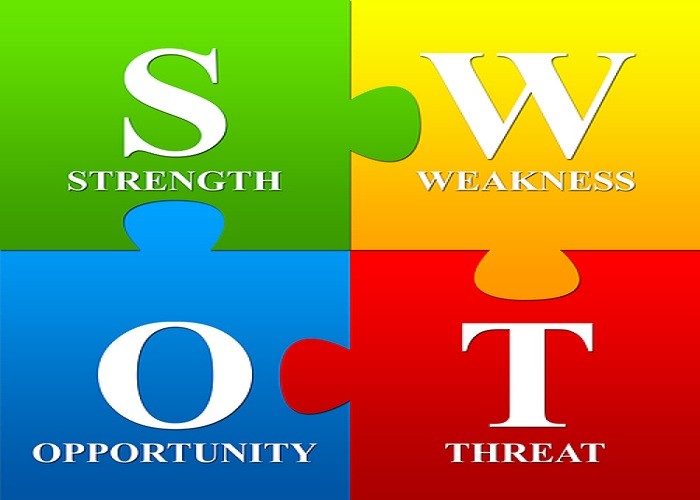When one embarks on a strategic planning exercise, management experts would advise the entrepreneur to examine the business’s internal and external environment. This is based on the premise that one can never identify the appropriate strategies to get to where one wants to bring his or her business without a current reality check first.
What do we mean by current reality check? This simply means that one has to identify the business’s strengths and weaknesses as well as its opportunities and threats. Strengths are positive factors internal to the business that will help it realize its objectives. Meanwhile, weaknesses are negative factors internal to the business that will hinder it from attaining its goals. On the other hand, opportunities are favourable situations that will boost the business’s position in the market while threats are negative situations which will prevent the business from gaining a favourable standing in the industry.
Because the market environment is governed by a lot of factors consequently making it highly dynamic, we could not expect to have strengths and opportunities only. The business shall be confronted with both weaknesses and threats as well.
How do we handle the various combinations of a business’s strengths, weaknesses, opportunities and strengths then? Here are some of them:
1. Given your strengths, you should exploit whatever opportunities come your way. Remember, that your strengths can help you grab and harness these opportunities.
2. If you are challenged by threats, you pre-empt them using your strengths. This is applicable when the threats are not yet effective and are still potential ones. However, when the threats are real and are affecting your position in the market, your option it to counter it. Again, your strengths will help you oppose the threats.
3. When you are aware of your weaknesses but there are opportunities in the business environment, you should focus only on a particular segment. This is applicable when you are short of some resources like employees or equipment. Though you may have the competence to serve the market but with such limitations, it is better if you will narrow your scope to a niche or several niches.
4. Oftentimes, you are confronted with threats that involve your weaknesses. When this happens, you should build up your business by improving on your weaknesses. Ideally, the goal is to convert the weaknesses to strengths. Once you are able to address your weaknesses and eliminate it, you can now confidently counter the threats.
But not all organizations have the funds to hire a trained consultant, and many situations do not afford the time to bring in outside help. For those who are forced to take the do-it-yourself approach to the above analysis also known by an acronym SWOT, these six tips will markedly improve your chances of a positive outcome.
1. SWOT is particularly useful in developing a quick perspective. It is a scan of the environment, not a detailed analysis. So, you’ll want to use SWOT analysis at the outset of your project, not in mid-stream.
2. SWOT analysis requires input from multiple levels of the organization and multiple disciplines in the organization, not just from the CEO or Executive Team. And if you really want a 360-degree view of your organization, you’ll solicit input from clients, and from delivery partners and from suppliers, as well.
3. SWOT is an effective approach to highly conceptual issues, like Brand. It combines free-style thinking with a disciplined approach to produce comprehensive, solid, and foundational observations. Yet, it also works well for very specific or tactical issues, like the development or launch of a new product. In fact, SWOT analysis performed at the product level will produce very different results than SWOT analysis at the organizational level. And the closer to the street you get with your SWOT analysis, the more actionable your outcomes become.
4. SWOT is less effective at the organizational level, for two reasons: First, individual characteristics may be strengths in one context and weaknesses in another – just as external issues may present opportunities or threats, depending on context. This creates ambiguity and may muddle the process. Second, because of its inherent ambiguities at the organizational level, SWOT results are not easily actionable, and without action steps, the SWOT process becomes an academic exercise and is soon forgotten.
5. SWOT is most effective when focused on the areas of greatest impact for the organization, not simply the most lucrative opportunities. The first step in identifying impact potential is to stack rank your opportunities and your threats. The highest priority opportunities would be the ones that advance your organization’s goals or mission. That could be growth, or profit, or sustainability, or reputation, or a hundred other metrics. Threats are prioritized in terms of size of the threat, and likelihood of the threat becoming a reality. And the second step is to identify strengths that can be leveraged to create opportunities or to combat threats, and weaknesses that must be addressed to avoid disaster.
6. Regardless of the level at which SWOT begins, it should be carried through to the individual product level of the organization, where ambiguity is less likely and where action steps can be identified and implemented.
As a final note, there are very important points to be considered on top of these possible actions and tips. First, when taking advantage of opportunities or pre-empting or countering threats, the business must do so with a sense of urgency. Opportunities do not wait. They only exist for as long as nobody else grabs them. You have to ensure that you are the first one to do so. Threats can also cause severe damage to the business’s industry position if not dealt with as early as possible. Second, it is not advisable to keep your weaknesses for very long. Again, the sense of urgency is very vital. Turn your weaknesses around because they are your competitors’ opportunities. Do not allow them to take advantage of it.
Let us know in the comment section below, what is your take on implementing SWOT for the success of your business….
Source: https://www.linkedin.com/pulse/how-respond-business-strengths-weaknesses-threats-sahil-gupta/






